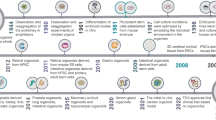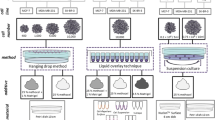Abstract
To investigate whether aldehyde dehydrogenase-1 (ALDH-1) in human lung cancer can be used as a sorting marker for stem cells in targeted therapies against human lung cancer. Spheres were induced by incubating cancer cells in a serum-free medium and formed with epidermal growth factor and fibroblast growth factor-10 (FGF10). Spheroid cells were combined with flow cytometry using the Aldefluor reagent to separate the SSCloALDEbr (ALDH-1-positive) cells. Cancer stem cells (CSCs) were characterized by their proliferation, colony formation, and tumorigenesis in nude mice and using phenotypic analysis. Float-growing spheres (“pulmospheres”) were developed after SPC-A1 cells were cultured in a serum-free medium. The resultant sphere-forming cells included ALDH-1-positive cells as high as 15.13%. ALDH-1-positive CSCs have high proliferative ability, high cloning efficiency, and strong tumorigenicity. The rate of SSCloALDEbr cell colony formation was 1.3–5.6%, whereas that of ALDE− cell colony formation was only 0–1.2% (P < 0.05). A cell count of only 1 × 103 SSCloALDEbr cells was necessary to form tumors, whereas at least l × 105 ALDE− cells formed tumors. The same number of SSCloALDEbr cells also formed larger tumors in a short latency period of tumor formation. The expression rates of CD133 in the SSCloALDEbr and ALDE− cells were 16.31% (16.31 × 104/106) and 2.56% (2.56 × 104/106), respectively (P < 0.01). Moreover, the expression rates of ABCG2 in SSCloALDEbr and ALDE− cells were 17.62% (17.62 × 104/106) and 3.45% (3.45 × 104/106), respectively (P < 0.01). Human lung adenocarcinoma bears CSCs, and ALDH-1 can act as a specific marker for human lung CSCs.





Similar content being viewed by others
References
Reya T, Morrison SJ, Clarke MF, et al. Stem cells, cancer, and cancer stem cells. Nature. 2001;414:105–11.
Lapidot T, Sirard C, Vormoor J, et al. A cell initiating human acute myeloid leukaemia after transplantation into SCID mice. Nature. 1994;367:645–8.
Bonnet D, Dick JE, et al. Human acute myeloid leukemia is organized as a hierarchy that originates from a primitive hematopoietic cell. Nat Med. 1997;3:730–7.
Singh SK, Hawkins C, Clarke ID, et al. Identification of human brain tumour initiating cells. Nature. 2004;432:396–401.
Singh SK, Clarke ID, Hide T, et al. Cancer stem cells in nervous system tumors. Oncogene. 2004;23:7267–73.
Al-Hajj M, Wicha MS, Benito-Hemandez A, et al. Prospective identification of tumorigenic breast cancer cells. Proc Natl Acad Sci USA. 2003;100:3983–8.
Collins AT, Berry PA, Hyde C, et al. Prospective identification of tumorigenic prostate cancer stem cells. Cancer Res. 2005;65:10946–51.
Suetsugu A, Nagaki M, Aoki H, et al. Characterization of CD133 + hepatocellular carcinoma cells as cancer stem/progenitor cells. Biochem Biophys Res Commun. 2006;351:820–4.
O′Brien CA, Pollett A, Gallinger S, et al. A human colon cancer cell capable of initiating tumour growth in immunodeficient mice. Nature. 2007;445:106–10.
Prince ME, Sivanandan R, Kaczorowski A. et al.: Identification of a subpopulation of cells witll cancer stem cell properties in head and neck squarnous cell carcinoma. Proc Natl Acad Sci USA. 2007;104:973–8.
Ginestier C, Hur MH, Charafe-Jauffret E, et al. ALDH-1 is a marker of normal and malignant human mammary stem cells and a predictor of poor clinical outcome. J Cell Stem Cell. 2007;12:555–67.
Ling Z, Pei Y, Jianfeng W, et al. Expression of aldehyde dehydrogenase 1 in breast cancer and its clinical significance. Tumor. 2009;29:663–7.
Giangreco A, Groot KR, Janes SM, et al. Lung cancer and lung stem cells: strange bedfellows? J Am J Respir Crit Care Med. 2006;175:547–53.
Mimeault M, Hauke R, Mehta PP, et al. Recent advances in cancer stem/progenitor cell research: therapeutic implications for overcoming resistance to the most aggressive cancers. J Cell Mol Med. 2007;11:981–1011.
Russo JE, Hilton J, et al. Characterization of cytosolic aldehyde dehydrogenase from cyclophosphamide resistant L1210 cells. Cancer Res. 1988;48:2963–8.
Labrecque J, Bhat PV, Lacroix A, et al. Purification and partial characterization of a rat kidney aldehyde dehydrogenase that oxidizes retinal to retinoic acid. Biochem Cell Biol. 1993;71:85–9.
Storms RW, Trujillo AP, Springer JB, et al. Isolation of primitive human hematopoietic progenitors on the basis of aldehyde dehydrogenase activity. Proc Natl Acad Sci USA. 1999;96:9118–23.
Hess DA, Meyerrosse TE, Wirthlin L, et al. Functional characterization of highly purified human hematopoietic repopulating cells isolated according to aldehyde dehydrogenase activity. Blood. 2004;104:1648–55.
Corti S, Locatelli F, Papadimitriou D, et al. Identification of a primitive brain-derived neural stem cell population based on aldehyde dehydrogenase activity. Stem Cells. 2006;24:975–85.
Balickid D, et al. Moving forward in human mammary stem cell biology and breast cancer prognostication using ALDH1. J Cell Stem Cell. 2007;1:485–7.
Jiang F, Qiu Q, Khanna A, et al. Aldehyde dehydrogenase-1 is a tumor stem cell-associated marker in lung cance. J Mol Cancer Res. 2008;101:330–8.
Eramo A, Lotti F, Sette G, et al. Identification and expansion of the tumorigenic lung cancer stem cell population. Cell Death Differ. 2008;15:504–14.
Acknowledgments
This study was supported by Heilongjiang Youth Science Foundation (Fund Code: QC2009C95).
Conflicts of interest
None.
Author information
Authors and Affiliations
Corresponding author
Rights and permissions
About this article
Cite this article
Liang, D., Shi, Y. Aldehyde dehydrogenase-1 is a specific marker for stem cells in human lung adenocarcinoma. Med Oncol 29, 633–639 (2012). https://doi.org/10.1007/s12032-011-9933-9
Received:
Accepted:
Published:
Issue Date:
DOI: https://doi.org/10.1007/s12032-011-9933-9




